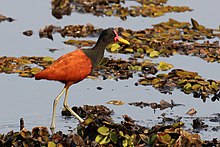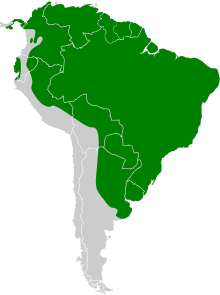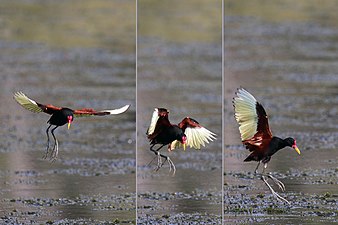| Wattled jacana | |
|---|---|

| |
| Adult J. j. jacana the Pantanal, Brazil | |
| Conservation status | |
 Least Concern (IUCN 3.1) | |
| Scientific classification | |
| Domain: | Eukaryota |
| Kingdom: | Animalia |
| Phylum: | Chordata |
| Class: | Aves |
| Order: | Charadriiformes |
| Family: | Jacanidae |
| Genus: | Jacana |
| Species: | J. jacana |
| Binomial name | |
| Jacana jacana (Linnaeus, 1766) | |

| |
| Synonyms | |
|
Parra jacana Linnaeus, 1766 | |
| This article includes a list of general references, but it lacks sufficient corresponding inline citations. Please help to improve this article by introducing more precise citations. (March 2013) (Learn how and when to remove this message) |
The wattled jacana (Jacana jacana) is a wader in the family Jacanidae found throughout much of South America east of the Andes, as well as western Panama and Trinidad. It is the only species in the Jacanidae family with such a large distribution. Wattled jacanas have long toes and claws which help them walk through aquatic vegetation. Like the majority of species of jacanas, the female is larger than the male, and forms harems of up to 4 or 5 males at any given time. There is also a major difference in proportional development or ornamentation (facial crest and wing size) and defense (length of wing spur) relative to body size when compared to males.
Etymology
"Jacana" comes from the Tupi word ñaha'nã which means "very loud bird".
Breeding
The wattled jacana lays four black-marked brown eggs in a floating nest. The male, as with other jacanas and some other wader families like the phalaropes, takes responsibility for incubation, with two eggs held between each wing and the breast. The females are polyandrous and will help to defend the nests of up to four mates.
Description
These are conspicuous and unmistakable birds. They are 17–23 cm (6.7–9.1 in) long, but the females are larger than the males. The adults have a chestnut back and wing coverts, with the rest of the body mainly black. In flight the greenish yellow flight feathers are obvious. Also visible are yellow bony spurs on the leading edge of the wings, which it can use to defend itself and its young. The yellow bill extends up as a red coot-like head shield and a reddish wattle, and the legs and very long toes are dull blue-grey.
Young birds initially have entirely white underparts, and can always be identified by the presence of white in their plumage.
Taxonomy
There are six subspecies, with the nominate J. j. jacana being the most widespread. Several of the other subspecies are similar, but J. j. hypomelaena of western Panama and northern Colombia has all the chestnut plumage replaced by black, and J. j. scapularis of western Ecuador has some black feathers on its chestnut shoulders, and white outer primary feathers.
-
Juvenile J. j. jacana
the Pantanal, Brazil -
J. j. jacana in flight
the Pantanal, Brazil -
 J. j. jacana alighting
J. j. jacana alighting
the Pantanal, Brazil
Subspecies
- J. j. hypomelaena (Gray, 1846): west-central Panama to northern Colombia
- J. j. melanopygia (Sclater, 1857): western Colombia to western Venezuela
- J. j. intermedia (Sclater, 1857): north & central Venezuela
- J. j. jacana (Linnaeus, 1766): Trinidad, southern Colombia & southern Venezuela through the Guianas south to eastern Bolivia, northern Argentina & Uruguay
- J. j. scapularis (Chapman, 1922): western Ecuador & northwestern Peru
- J. j. peruviana (Zimmer, 1930): northeastern Peru & northwestern Brazil
This species produces a range of noisy rattling calls.
Diet
The wattled jacana's food is insects (such as beetles, grasshoppers and crickets), other invertebrates (e.g. ticks and mollusks), small fish, roots and seeds picked from the floating vegetation or the water's surface.
-
 Immature J. j. hypomelaena
Immature J. j. hypomelaena
Chagres River, Panama -
 Subadult J. j. hypomelaena
Subadult J. j. hypomelaena
Chagres River, Panama -
 Adult J. j. hypomelaena
Adult J. j. hypomelaena
Chagres River, Panama
References
- BirdLife International (2020). "Jacana jacana". IUCN Red List of Threatened Species. 2020: e.T22693553A163616643. doi:10.2305/IUCN.UK.2020-3.RLTS.T22693553A163616643.en. Retrieved 11 November 2021.
- STRAUBE, Fernando C. et al. Aves de Curitiba: coletânea de registros. Curitiba: Hori Consultoria Ambiental, 2009.
- French, Richard; O'Neill, John Patton; Eckelberry, Don R. (1991). A Guide to the Birds of Trinidad and Tobago (2nd ed.). Ithaca, N.Y.: Comstock Publishing. ISBN 0-8014-9792-2.
- ^ Gill, Frank; Donsker, David, eds. (2019). "Grebes, flamingos, buttonquail, plovers, painted-snipes, jacanas, plains-wanderer, seedsnipes". World Bird List Version 9.2. International Ornithologists' Union. Retrieved 26 June 2019.
- Emlen, Wrege, Stephen T, Peter H (1 April 2004). «Size Dimorphism, Intrasexual Competition, and Sexual Selection in Wattled Jacana (Jacana jacana), A Sex-Role-Reversed Shorebird in Panama». Oxford Academic, Ornythology. Accessed 11 Novembro 2021.
- FERREIRA, A. B. H. Novo Dicionário da Língua Portuguesa. Segunda edição. Rio de Janeiro: Nova Fronteira, 1986. p.978
- ^ "Jacana jacana (Wattled Jacana or Tek Teky)" (PDF). Sta.uwi.rfu. Retrieved 29 March 2022.
- Hayman, Peter; Marchant, John; Prater, Tony (1991). Shorebirds: An Identification Guide to the Waders of the World. Houghton Mifflin Harcourt. ISBN 9780395602379.
- Hilty, Steven L. (2003). Birds of Venezuela. Princeton University Press. ISBN 0-7136-6418-5.
- ffrench, Richard; O'Neill, John Patton; Eckelberry, Don R. (1991). A Guide to the Birds of Trinidad and Tobago (2nd ed.). Ithaca, N.Y.: Comstock Publishing. ISBN 0-8014-9792-2.
External links
- BirdLife species factsheet for Jacana jacana
- "Wattled jacana media". Internet Bird Collection.
- Wattled jacana photo gallery at VIREO (Drexel University)
- Wattled jacana species account at Neotropical Birds (Cornell Lab of Ornithology)
- Interactive range map of Jacana jacana at IUCN Red List maps
- Audio recordings of Wattled jacana on Xeno-canto.